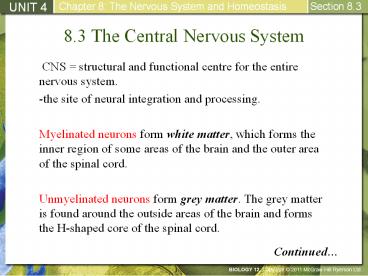8.3 The Central Nervous System - PowerPoint PPT Presentation
Title:
8.3 The Central Nervous System
Description:
8.3 The Central Nervous System CNS = structural and functional centre for the entire nervous system. -the site of neural integration and processing. – PowerPoint PPT presentation
Number of Views:99
Avg rating:3.0/5.0
Title: 8.3 The Central Nervous System
1
8.3 The Central Nervous System
UNIT 4
Chapter 8 The Nervous System and Homeostasis
Section 8.3
- CNS structural and functional centre for the
entire nervous system. - -the site of neural integration and processing.
- Myelinated neurons form white matter, which
forms the inner region of some areas of the brain
and the outer area of the spinal cord. - Unmyelinated neurons form grey matter. The grey
matter is found around the outside areas of the
brain and forms the H-shaped core of the spinal
cord.
Continued
2
The Central Nervous System
UNIT 4
Chapter 8 The Nervous System and Homeostasis
Section 8.3
3
The Spinal Cord
UNIT 4
Chapter 8 The Nervous System and Homeostasis
Section 8.3
- The spinal cord extends out of the skull from
the brain and downward through a canal within the
backbone.
Sensory and motor nerves are found within the
spinal cord. It is also the primary reflex
centre. The tissues are protected by
cerebrospinal fluid, soft layer tissues, and the
spinal column (vertebrae). Injury to the spinal
cord can result in paralysis.
The spinal cord is protected by the meninges and
the bony vertebrae.
4
The Brain
UNIT 4
Chapter 8 The Nervous System and Homeostasis
Section 8.3
- The brain is protected by the skull and the
meninges.
The brain is divided into 3 general regions
- hindbrain
- midbrain
- forebrain
Three layers of tissue, called the meninges,
surround and protect the brain and spinal cord.
5
The Hindbrain Coordination and Homeostasis
UNIT 4
Chapter 8 The Nervous System and Homeostasis
Section 8.3
A cerebellum involved in unconscious
coordination of posture, reflexes, body movement,
and fine voluntary motor skills B medulla
oblongata
coordinates automatic
bodily functions that
maintain
homeostasis,
including heart rate and
breathing C pons relay centre
between right and left
halves of the brain
6
Midbrain Processing Sensory Input
UNIT 4
Chapter 8 The Nervous System and Homeostasis
Section 8.3
D midbrain processes information from the
eyes, ears, and nose and controls skeletal muscle
movement
7
Forebrain Thought, Learning, and Emotion
UNIT 4
Chapter 8 The Nervous System and Homeostasis
Section 8.3
E thalamus connections btw the forebrain
hindbrain F hypothalamus regulates bodys
internal environment, (ie. behaviour, blood
pressure, heart rate, body temperature, hunger,
thirst) G cerebrum divided into
right and left cerebral
hemispheres each
contain
centres for intellect,
learning, memory,
consciousness, and language
8
The Blood-Brain Barrier
UNIT 4
Chapter 8 The Nervous System and Homeostasis
Section 8.3
The blood-brain barrier is formed by glial cells
and blood vessels. It separates the blood from
the CNS and selectively controls the entrance of
substances into the brain from the blood.
The brain requires a constant supply of oxygen
and glucose. Both of these substances can cross
the blood-brain barrier through special transport
mechanisms. Lipid-soluble substances (caffeine,
nicotine, alcohol) have rapid effects on brain
function because they are able to pass directly
through the barrier.
Continued
9
The Blood-Brain Barrier
UNIT 4
Chapter 8 The Nervous System and Homeostasis
Section 8.3
10
Cerebrospinal Fluid
UNIT 4
Chapter 8 The Nervous System and Homeostasis
Section 8.3
-A dense, clear liquid derived from blood plasma.
-It transports hormones, white blood cells, and
nutrients across the blood-brain barrier to the
cells of the brain. -Shock absorber circulates
between 2 layers of the meninges (the arachnoid
and pia mater).
11
The Structure and Function of the Cerebrum
UNIT 4
Chapter 8 The Nervous System and Homeostasis
Section 8.3
Each half of the cerebrum contains a mass of
white matter and a thin, outer covering of grey
matter called the cerebral cortex. The cerebral
cortex is responsible for language, memory,
personality, vision, conscious thought, and
emotion. The right and left halves (the
cerebral hemispheres) are linked by the corpus
callosum. The corpus callosum sends messages from
one hemisphere to another.
The folds on the cerebral cortex increase the
surface area of grey matter in the cerebrum.
12
The Cerebrum
UNIT 4
Chapter 8 The Nervous System and Homeostasis
Section 8.3
Cognitive functions originate from both
right-brain (right cerebral hemisphere) and
left-brain (left-cerebral hemisphere) components.
However, some functions have a dominant
hemisphere
- the right-brain is associated with holistic and
intuitive thinking, visual-spatial skills, and
artistic abilities - the left-brain is associated with sequential and
logical ways of thinking, and linguistic/mathemati
cal skills
13
The Cerebral Cortex
UNIT 4
Chapter 8 The Nervous System and Homeostasis
Section 8.3
Four lobes
- occipital lobes receive and analyze visual
information - temporal lobes share some visual processing but
mainly process auditory information
Continued
14
The Cerebral Cortex
UNIT 4
Chapter 8 The Nervous System and Homeostasis
Section 8.3
- parietal lobes receive and process sensory
information from the skin - frontal lobes integrate info and controls
critical thinking, memory, personality, and fine
motor skills. Each side of the frontal lobes
controls muscles on the opposite side of the body.































